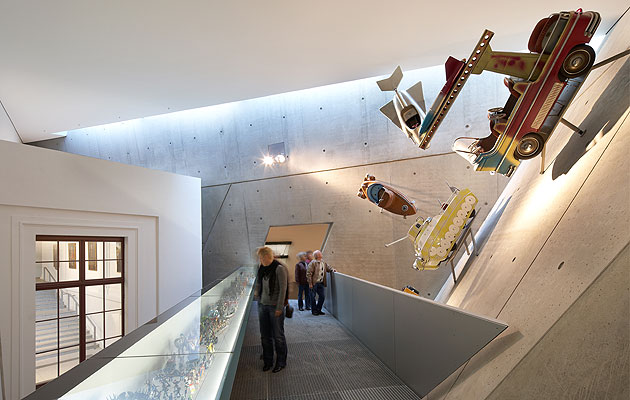|
|
||
|
It’s been a strange decade for Daniel Libeskind. Just over 10 years ago he was the “deconstructivist” architect of the Jewish Museum Berlin, one of the most important buildings of the late 20th century, but at the time was still mostly known for his abstract works and unbuilt schemes that interrogated cultural history in a way that no other architect was capable of. Since then, however, there has been his difficult experience with the project for the World Trade Center site, where he won the competition but was then rudely sidelined by commercial interests; there’s also his transition into a busy signature world architect, like his peers Gehry and Hadid. If it might be said that his move into culturally insignificant projects such as shopping malls and hotels puts a strain on the dense spatial language that he developed in his early career, then we might also say that his new extension of the Dresden Military Museum is an example of the architecture that he is the very best at. “I couldn’t respond to this as just another military history museum,” says Libeskind.At the time of the competition the museum was a mess, with a morass of small buildings surrounding the 135-year-old arsenal, and a thoroughly kitsch GDR-era curatorial strategy which barely compensated for the previous Nazi history of the museum. Libeskind’s typically bold concept for the project was to propose a new wedge-shaped structure that would intersect with the older building, breaking its symmetry and opening up a tense spatial dialogue in which to create a new curatorial narrative: “My strategy was a very simple one,” Libeskind explains. “That one would have – in a very bold way – to interrupt and give a new perspective to the city itself, and to penetrate through the arsenal, and create a new experience that connects people to the military in a democratic society.” The new building cuts vertically across the existing museum building in the form of a five-storey “wedge”. Dramatically bursting forward over one wing of the building, its perforated steel skin shields a viewing platform that faces south towards the centre of rebuilt Dresden, which was utterly devastated by the firebombing of 1945. “The interruption with this vertical structure happens exactly when WWI and WWII happen,” Libeskind explains. “It interrupts the chronology which is in the arsenal’s horizontal structure, and creates a new spatiality where the questions come: why is there organised violence, why is there war, why do people conform to authoritarian and totalitarian regimes?” Unlike the Jewish Museum Berlin, with its notoriously disjunctive curating, Libeskind was involved in the curatorial strategy from the beginning, and the results have been typically popular with the public. Libeskind is at his best when creating a charged reinterpretation of an existing structure, where the weight of the cultural subject that the building embodies is expressed through its juxtapositions, tensions and fragments, and in this sense the Dresden Military Museum is vintage Libeskind.
credit Hufton+Crow Photography
credit © Bitter Bredt Courtesy of Holzer Kobler Architekturan |
Image © Bitter Bredt Courtesy of Holzer Kobler Architekturan
Words Douglas Murphy |
|
|
||



















